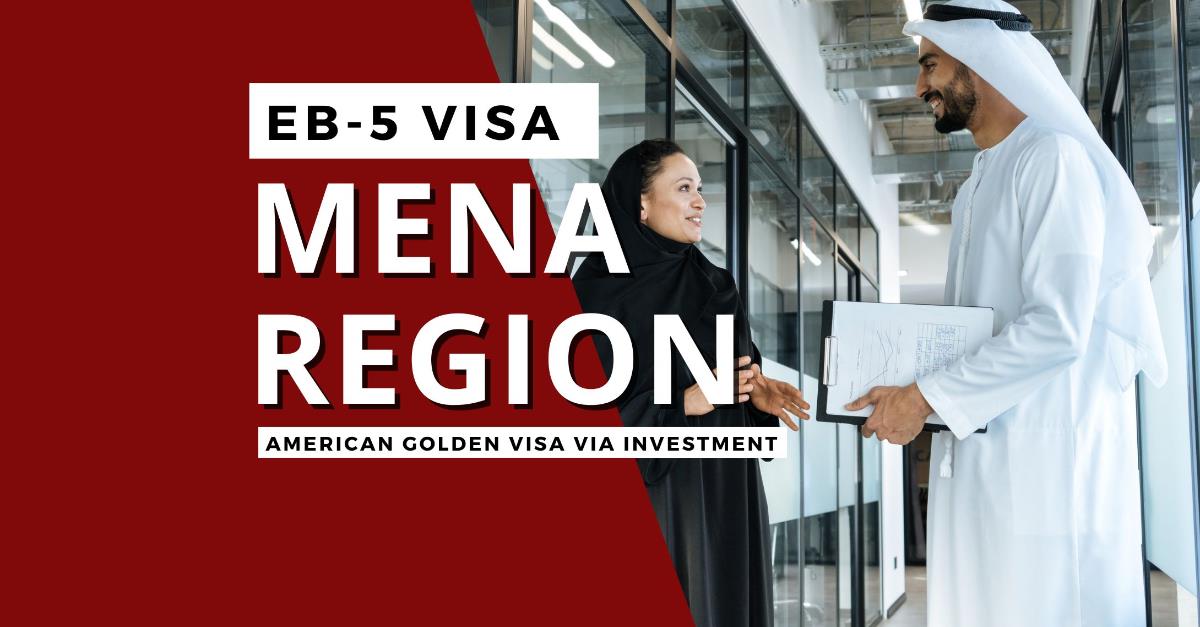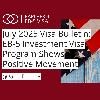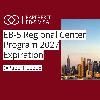Why the EB-5 Visa is a Prime Option for MENA Investors
Securing a Brighter Future: How MENA Investors Can Achieve U.S. Residency Through the EB-5 Visa Programlast updated Monday, May 26, 2025
#EB5 visa mena region #EB-5 visa
| | by Sidra Jabeen | Content Manager, Paperfree Magazine |

QUICK LINKS
AD
Get Access to EB 5 Investment Visa Resources
In the pursuit of global mobility and financial security, high-net-worth individuals (HNWI) from the Middle East and North Africa (MENA) are increasingly turning their gaze towards the United States’ EB-5 visa program.
This program not only offers a pathway to residency but stands as a testament to the U.S.'s welcoming policy for investors who are ready to contribute to its economy.
This blog explores why the EB-5 visa is beautiful to MENA investors and how it aligns with their aspirations and needs.
Understanding the EB-5 Visa
The EB-5 visa program allows foreign investors to gain permanent residency in the U.S. by investing in government-approved projects that create U.S. jobs. It requires a minimum investment of $900,000 in targeted employment areas (TEA) or $1.8 million outside TEAs, making it a substantial yet viable option for those looking to relocate and invest in a stable economy.
Why MENA Investors Choose the EB-5 Visa Program?
- Global Mobility and Enhanced Security: MENA regions often grapple with political and economic instability. The EB-5 visa serves as a gateway to stability, offering investors and their families a safe harbour in the U.S., which is renowned for its robust economy and democratic values.
- Access to Premier Education and Healthcare: The U.S. is home to some of the world's leading educational institutions and state-of-the-art healthcare facilities. For MENA investors, this translates into future-proofing their family’s education and well-being.
- Investment with Potential Returns: Unlike other visa programs that require a donation, the EB-5 visa is an investment, providing a potential return depending on the success of the project invested in. This feature is beautiful as it aligns with the investor's goal to not only secure residency but also to ensure financial growth.
For more detailed information about the repayment process for EB-5 investments and what to expect after the job creation requirements are met, please visit our comprehensive guide on EB-5 Investment Repayment.
The Future of EB-5 in MENA: A Flourishing Prospect Amidst Regional Growth
As we look towards the future of the EB-5 visa program in the Middle East and North Africa (MENA), a clear trend emerges. There is a growing inclination among high-net-worth individuals (HNWIs) to seek more stable and economically promising horizons, particularly in the United States. This uptick in interest and applications is strongly tied to both economic forecasts and the shifting political landscape of the region.
Economic Forecasts Driving Interest
Economic resilience in the Gulf Cooperation Council (GCC) countries, spearheaded by the UAE and Saudi Arabia, continues to play a pivotal role in shaping investment behaviours and decisions.
The UAE's economy, known for its rapid diversification away from oil reliance, has become a hub for international business, drawing investors towards opportunities that promise global mobility and secure financial futures.
Similarly, Saudi Arabia's Vision 2030 initiative, which aims to reduce the kingdom's dependence on oil, diversify its economy, and develop public service sectors such as health, education, infrastructure, recreation, and tourism, signals a robust economic expansion that HNWIs are eager to participate in.
These economic transformations are not just internal successes but are creating ripples across the global investment landscape. For MENA investors, this means reevaluating wealth management strategies, with many looking to the EB-5 visa as a pathway to diversify their investment portfolios and secure a stable and prosperous future for their families.
To explore the latest updates and enhancements to the EB-5 funding process, you can check out our detailed article on EB-5 Funding 3.0, which offers essential insights into navigating these developments effectively.
Political Dynamics and Mobility
The political climate in many MENA countries often presents challenges that can influence personal and business decisions. Issues ranging from political instability to economic sanctions can drive the region's affluent individuals to seek safer, more predictable environments. The U.S., with its stable political framework and strong rule of law, offers a contrast to the unpredictability that can sometimes permeate the MENA region.
The EB-5 program, offering a direct route to U.S. residency, is particularly appealing as it provides not just an escape from potential regional instability but also access to a lifestyle and business environment that is conducive to growth and prosperity.
Regional Developments Influencing Investment Directions
The burgeoning economies of the UAE and Saudi Arabia are particularly influential. They act as beacons of economic and social liberalisation policies that are attractive to foreign investors.
As these countries enhance their international standing and global connectivity, they serve as prime examples of the potential benefits associated with investing in and through the EB-5 program.
The infrastructural and developmental strides being made in these countries not only boost local economies but also position them as leaders in the broader MENA region, guiding investment trends and decisions.
For EB-5 investors, this can mean more strategic investment opportunities in projects that are not only financially promising but also backed by governmental economic policies designed to ensure long-term growth and stability.
Challenges and How Paperfree Addresses Them:
- Navigating Source of Funds Regulations: MENA investors often face challenges with the stringent 'source of funds' requirements of the EB-5 program. Paperfree assists in meticulously documenting the investment capital's origin, ensuring compliance with U.S. regulations.
- Dealing with U.S. Sanctions and Legal Complexities: Investors from countries like Iran and Syria must navigate U.S. sanctions. Paperfree’s legal experts are well-versed in OFAC regulations and provide strategic advice to manage these challenges successfully.
FAQs:
What are the financial requirements for MENA investors to qualify for the EB-5 visa?
MENA investors must invest either $800,000 in a Targeted Employment Area (TEA) or $1.8 million in non-TEA projects. These investments must be at risk and aimed at creating at least ten full-time jobs for U.S. workers to qualify for the EB-5 visa.
How can MENA investors prove the legality of their funds for the EB-5 visa investment?
MENA investors need to provide detailed documentation tracing the source and path of the funds used for the EB-5 investment. This may include bank statements, business records, tax returns, and any other documents that can establish the legal acquisition and ownership of the funds.
What types of business ventures in the U.S. are eligible for EB-5 investments from MENA nationals?
EB-5 investments can be made in any commercial enterprise that will create at least ten full-time jobs for U.S. workers. This includes new businesses, troubled businesses, or regional centre projects in various industries such as real estate, manufacturing, technology, and more.
Are there any specific legal challenges that MENA investors face when applying for the EB-5 visa?
MENA investors may need help with the documentation of funds, especially if those funds come from countries with less transparent banking systems or from areas with political instability. Additionally, investors from sanctioned countries may require special permissions or face extra scrutiny.
How does the U.S. Citizenship and Immigration Services (USCIS) handle EB-5 applications from MENA countries with political tensions or sanctions?
USCIS scrutinises EB-5 applications to ensure compliance with U.S. laws, including international sanctions. Investors from countries under U.S. sanctions might need to obtain specific licenses or go through additional legal processes to prove their funds are not linked to activities that would violate U.S. laws.
What are the success rates of EB-5 visa applications for investors from the MENA region?
While specific success rates for MENA investors are not publicly detailed, the overall approval rate for EB-5 applications has historically been high. Success largely depends on the proper structuring of the investment and adherence to legal requirements.
Can MENA investors include real estate investments in their EB-5 visa application?
Yes, real estate projects can qualify for EB-5 investments if they meet the job creation requirements. MENA investors often participate in large-scale real estate developments through Regional Centers to satisfy the EB-5 criteria, ensuring that their investments lead to the creation of the necessary number of jobs.
Final Thoughts
The EB-5 visa presents a formidable opportunity for MENA investors seeking stability, growth, and global mobility. The Paperfree EB-5 Visa Program enriches this opportunity by offering bespoke services tailored to the unique needs of MENA investors. By choosing Paperfree, investors not only step towards securing a U.S. green card but also engage with a partner that ensures their investment journey is smooth, compliant, and potentially rewarding.
Take the first step towards unlocking a world of opportunities in the United States. Join the ranks of savvy investors who choose stability, growth, and prosperity. Schedule your free 60-minute consultation and evaluation with Paprefree Expert Visa Consultants for the MENA Region.
Pages Related to #EB5 visa mena region
- Papefree EB5 investors magazine your source for EB5 insights. EB5 News.

- EB5 Investment Visa Guide 2025

- Paperfree Investment Visa EB-5 Program is Your Your Clear Path to Green Card USA

- US Immigration: Big increase in EB–5 visa fees proposed

- July 2025 Visa Bulletin: EB-5 Investment Visa Program Shows Positive Movement

- EB-5 for Tech Entrepreneurs: Immigration Program for Startup Founders | Paperfree

- EB-5 Regional Center Program 2027 Expiration: Secure Your Green Card Before Deadline | Renewal Updates

- EB-5 Investment Protection: How Experienced Developers Safeguard Your Capital | Paperfree

Popular Page
Benefits of the EB-5 Visa Program| A Comprehensive Guide
Book a Free Complimentary Call
real estate investing Investment Visa USA Investment Magazine Private Real Estate Funds real estate funds
